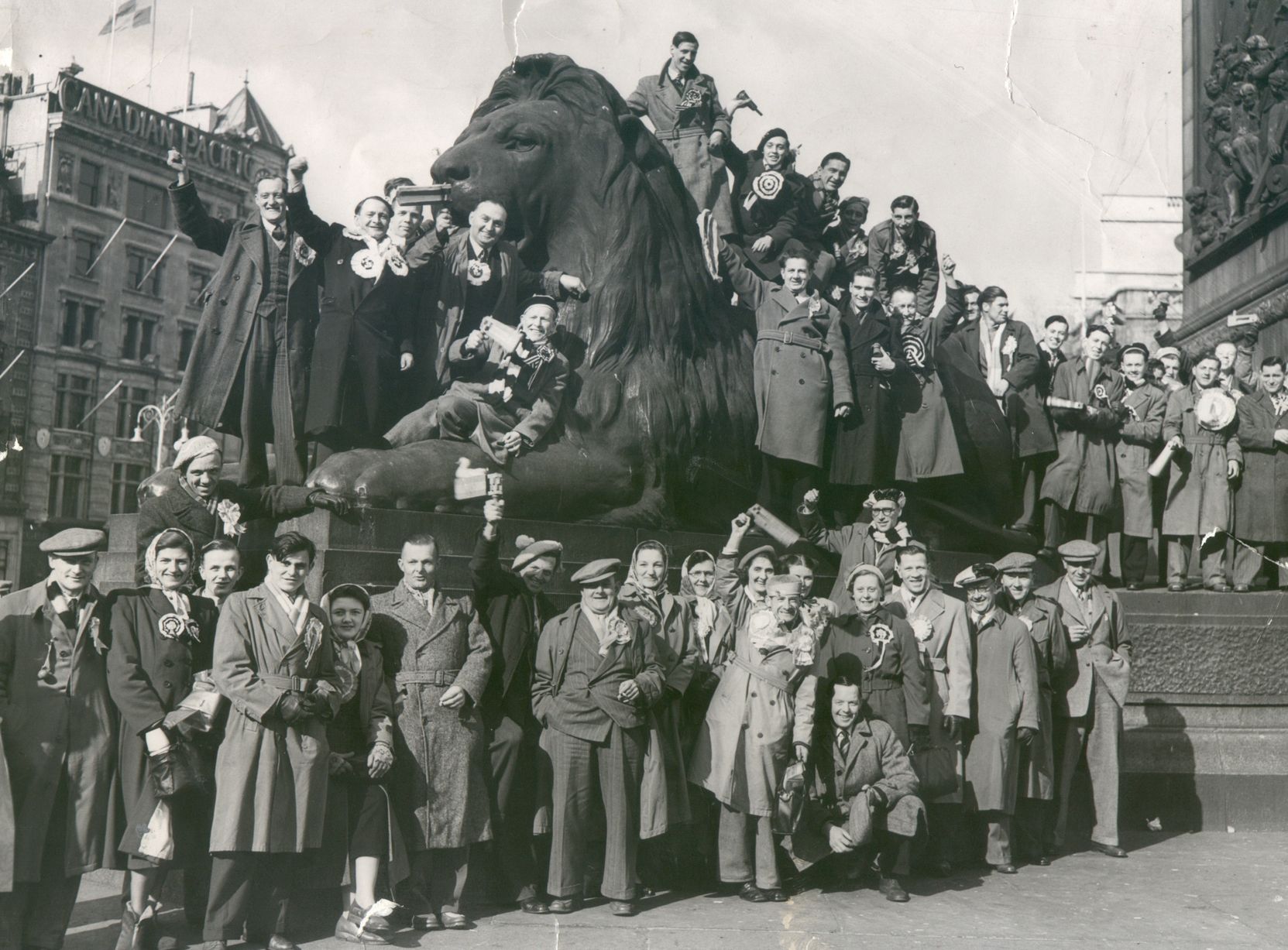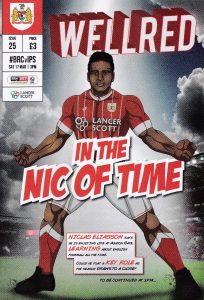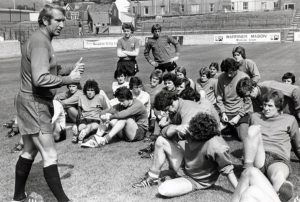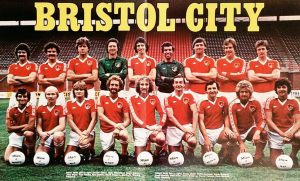Bristol City 1 Ipswich Town 0
Championship
Saturday 17 March 2018
The context
Unfamiliar territory for us. John had never visited Bristol, while my last Ashton Gate match saw City lose 1-0 against Port Vale in September 1988.
Our family home was here between 1973 and 1977. I returned during the mid-Eighties, living in Redland and Clifton while doing casual work at Avonmouth Docks. This city holds many memories, almost all good; today therefore had sentimental journey written all over it. Did my heart feel yearny? Maybe.
The history
Bristol sprawls. Folklorists traditionally described it as spanning seven picturesque hills, but low-lying Ashton Gate – near the River Avon and Floating Harbour – has long been prosaically industrial. Collieries and ironworks thrived here during Victorian times, with tobacco subsequently becoming the principal local industry. W.D & H.O.Wills (later Imperial Tobacco) opened a massive factory in Southville, while huge bonded warehouses still tower above Cumberland Road.
Railway infrastructure followed. Isambard Brunel’s ornate Temple Meads station had opened in 1840, and a branch connected Portbury docks with the main line at Parson Street. This passed near Bedminster FC. When Bedminster merged with Bristol City the new club initially used Bristol’s ground, St John’s Lane, before returning to Ashton Gate. They joined the Football League soon afterwards and were playing first Division football by 1906.
A new station helped transport spectators. Its platforms lay just north of modern Brunel Way. Goods lines splayed out across Ashton Meadow towards Bristol docks, connecting the Portishead branch line with Cumberland Basin via Ashton Avenue Bridge. Passenger traffic lasted until Beeching’s cuts; football specials, however, continued to stop here throughout the Seventies, and passenger services briefly resumed when American evangelist Billy Graham preached at Ashton Gate in 1984.
This area suffered particularly badly from German air raids during World War 2. Resultant devastation explains 1950s-era roads, roundabouts, subways and other brutalism beyond Greville Smyth Park. Bombing also affected City, whose imaginatively-named No.1 Stand was struck twice. A new Grand Stand, progressively expanded and later named after chairman Des Williams, took its place. No.2 opposite survived until the late 1960s.
People our age often think of Bristol City as a top flight club fallen from grace. This largely unjustified perception dates back to their brief Seventies spell in Division One, when Alan Dicks’ team struggled for points but were nonetheless very attractive to watch. Essentially average players from that era such as Peter Cormack, Geoff Merrick, Gerry Gow and Trevor Tainton have acquired almost mythical status. Ashton Gate oozed disco fever as City enthusiastically embraced NASL-type razamatazz, with fans often enduring bizarre pre-match entertainment.
You can read about pre-match entertainment here , and City’s 1976-77 season here .
It all ended badly. Relegation (accompanied by inevitable “Dicks out” jokes) concluded 15 years’ loyal managerial service. Subsequent decline was swift, and two successive relegations left City in the Fourth Division. That they didn’t fold altogether owed much to senior players – Tainton, Merrick, Chris Garland, Jimmy Mann, Julian Marshall, Dave Rodgers, Gerry Sweeney and Peter Aitken – cancelling their contracts. This group became known as the “Ashton Gate Eight”. Commentators showed little sympathy at the time; now, though, a plaque commemorates genuine sacrifice by modestly-salaried men with mortgages to pay.
Older City fans revere John Atyeo. Every team had one-club men until the maximum wage was abolished; even so, Atyeo was exceptional. The essential humility of his story makes this Southern version of Tom Finney a special case. Statistics speak for themselves; 645 appearances and 351 goals across 16 seasons, 6 England caps while playing part-time in the Second Division. Had bids from Chelsea, Spurs. Liverpool or Milan been accepted he would have been England’s most expensive player.
Atyeo signed semi-professional forms on 14 March 1951. Well, actually his father did. Harry Dolman, City’s engineer chairman, badly wanted to capture this promising amateur so walked along the main railway line from Dilton Marsh to a signal box where Atyeo senior worked. John first combined football with quantity surveying and then taught mathematics, spending just five seasons playing professionally. He later became deputy headmaster at Warminster’s Kingdown School.
The journey
After the Norwich disaster our trip proved trouble-free. Snow fell all around but no-one played or had fun, it was too bloody cold. Clifton evoked fridges more than bridges today as we drove along the Avon’s southernmost bank and marvelled at Brunel’s masterpiece. On to Bedminster, where friendly cricket club volunteers offered civilised matchday parking for considerably less than some blatant rob dogs in a nearby field.
The ground
- rain
- red
- restricted
- Renault
(all pictures: Groundtastic)
I loved coming here in the 1980s. City might have fallen on quiet times but Ashton Gate retained the atmosphere and scale of more successful days. It was a nice walk from Clifton – down Granby Hill, past Cumberland Basin and over Ashton Avenue Bridge, skirting the remains of Ashton Meadows sidings then across Greville Smyth Park until red-painted stands loomed through the trees. Third Division football meant this pleasant open space now suffered comparatively little hooligan mither; my only worry most Saturdays was some fierce dogs guarding gipsy caravans beside the river.
The East End terrace could still act the febrile bearpit if occasion demanded. This it did on New Year’s Day 1988, when City faced a mundane Brentford side and trailed 3-0 at half time. Manager Terry Cooper introduced his only sub, assistant manager and former Leeds team-mate Joe Jordan. Encouraged by the simmering five-figure crowd urging snarling, toothless Jordan into tackles that would be illegal today,they rallied to 2-3 and very nearly levelled matters . It remains the best impact substitution I have ever seen.
- Dolman (Bob Lilliman)
- Williams
- Covered
- Open
Tobacco adverts – something else not allowed today – survived here for many years. They once adorned all four sides – Dolman Stand, Williams Stand, Covered (East) End and Open End. The former was a great slab-sided thing built in 1970. Dolman, ever a keen engineer, masterminded its design and also that of Ashton Gate’s unusual “drenchlighting” system. His massive pylons with their brooding, inward-leaning lamps dominated the Bristol skyline for four decades.
Into the present. Despite not having moved at all, East is now confusingly called South. The 1920s roof I knew lasted until 2014 but then disappeared as part of major redevelopment work that saw City begin groundsharing with Bristol Rugby. One vast seated tier now sweeps round from the Dolman’s regenerated rump to an enormous but slightly awkward-looking new stand. The old Open End retains its modest post-Taylor all-seater named after John Atyeo. .
An official “singing section” is somehow necessary in modern grounds. City’s didn’t make much noise today, and the liveliest area – I use that adjective guardedly – seemed to be our wedge of unreserved seating. Everyone around us managed to enjoy themselves; it felt like the old EE’s spiritual reincarnation, and I enjoyed hearing Sky-era fans celebrating the Ashton Gate Eight with “They tore their contracts up so we could go on”.
After that 1988 game we exited the East End to find one disgruntled spectator had put a brick through City’s dressing room window (which in those days was temptingly exposed to the main car park). Fans dealt with disappointment badly back then. No amount of drummers, mascots and shiny new stands will bring that passion (misjudged or not) back to football grounds; our world has moved on too far.
Flesh and wine
Applying our favoured “nearest pub” method we quickly decided on the cosy (ie rammed to bursting point) and outrageously be-muralled Coopers Arms. Initial pleasantries over – a Stasi-like grilling by the landlady establishing that we didn’t come from Ipswich and had no intention of trashing her premises – everyone proved very friendly. Especially some Germans, although I’m not actually sure what they were doing there.
Ashton Gate is very big on the whole fanzone experience. Dozens of massive food vans sell “gourmet” stuff outside, which might be because this ground also stages rugby union (the Barbour brigade like that sort of thing). Needless to say I ignored all those and bought a lamb and mint pasty for three quid from the Clark’s Pies trailer on Ashton Road. Very good it was too.
The game
City were fresh from League Cup glory against Manchester United and fancying their play-off chances. Ipswich had been managed by Mick McCarthy for six years and exemplified the Barnsley maestro’s trademark fluid football. When Milan Duric stooped to head in a Lloyd Kelly cross – of the kind usually described as “wicked” – it belied ninety minutes of general mediocrity. So adventurous was Mick’s approach that he swapped strikers four minutes into added time. Fortune favours the brave.
Teams and goals
Bristol City: Fielding, Pisano, Wright, Magnusson (Hegeler 71), Kelly, Brownhill, Pack, Smith, Paterson (O’Neil 83), Reid, Diedhiou (Duric 56). Unused subs: Walsh, Wollacott, Diony, Kent.
Ipswich: Bialkowski, Spence, Carter-Vickers, Chambers, Webster, Knudsen, Ward (Celina 83), Skuse, Connolly, Sears (Morris 94), Waghorn. Unused subs: Hyam, Crowe, Gleeson, Drinan, Kenlock.
Goal: Djuric (64)
Attendance: 21,509


























